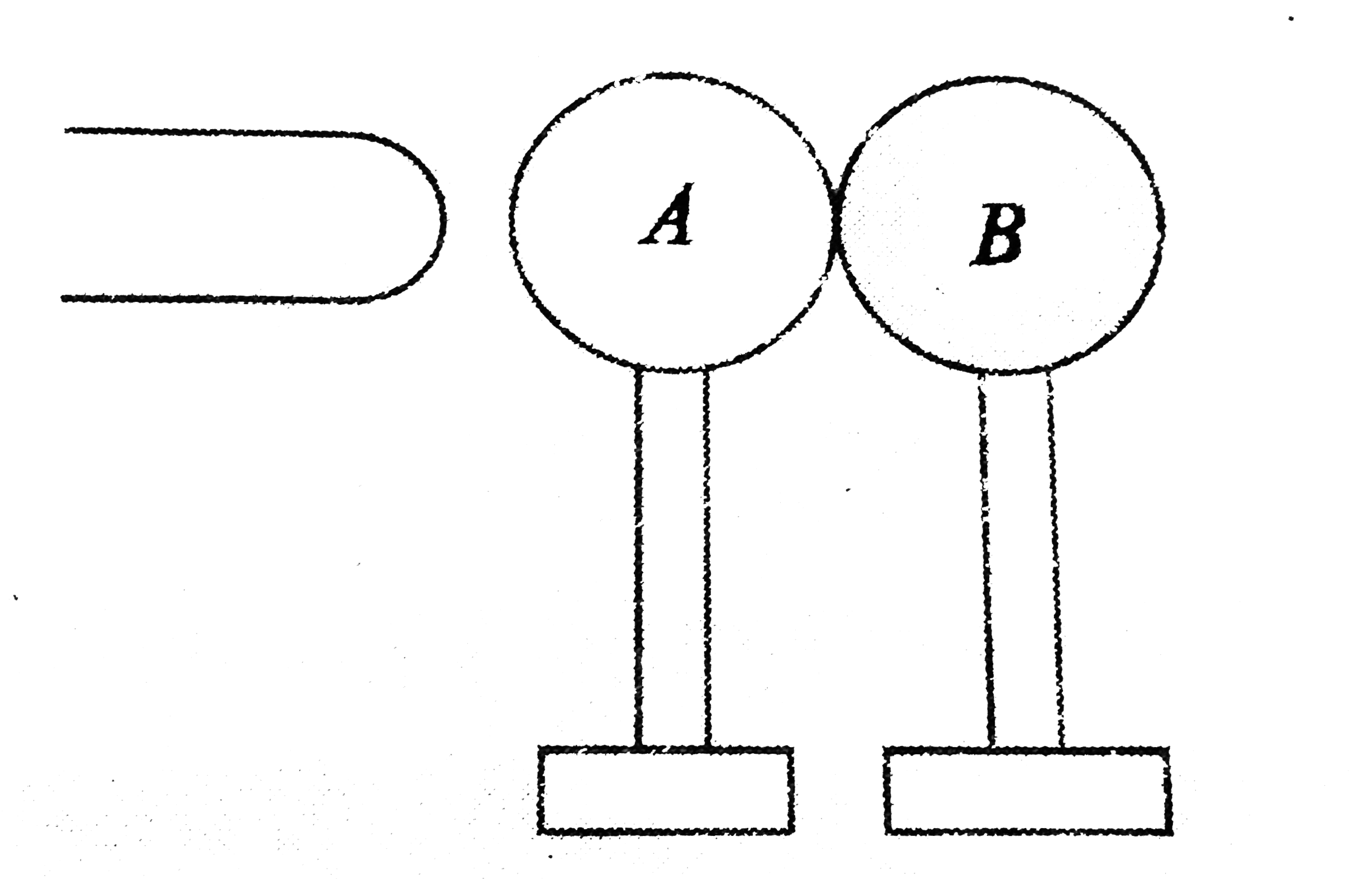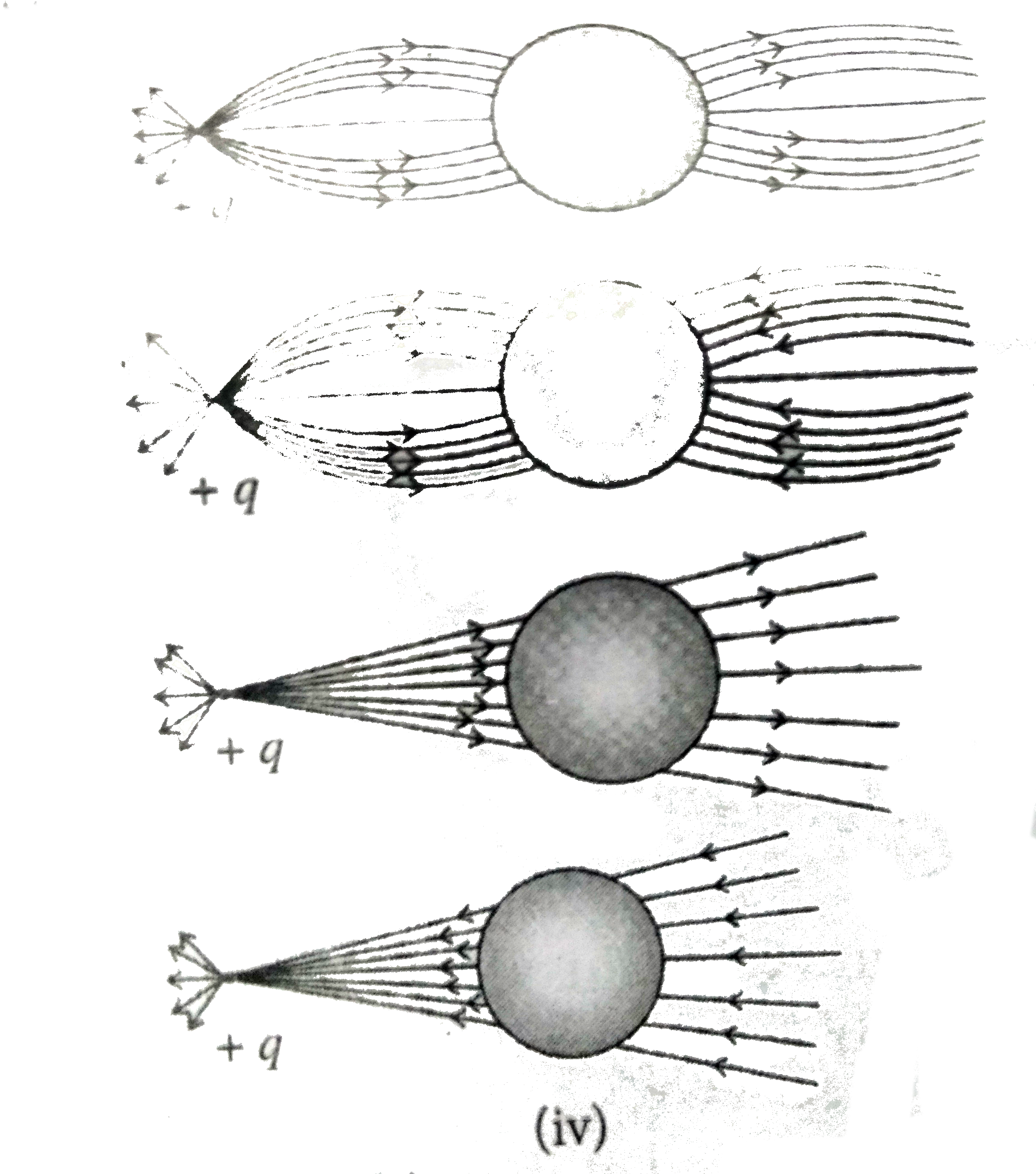A positive point charge q is brought near a neutral metal sphere.
The sphere becomes negatively charges.
The sphere becomes positively charged.
The interior remains neutral and the surface gets non-uniform charge distribution.
The interior becomes positively charged and the surface becomes negatively charged.
The correct Answer is:C
To solve the problem of a positive point charge q being brought near a neutral metal sphere, we can break down the situation step by step.
1. Understanding the System:
- We have a neutral metal sphere, which is a conductor. In its neutral state, it has equal amounts of positive and negative charges distributed evenly.
Hint: Remember that a neutral conductor has no net charge, but it can redistribute its charges when influenced by an external electric field.
2. Introducing the Point Charge:
- When a positive point charge +q is brought near the neutral metal sphere, it creates an electric field around it. This electric field will influence the charges within the metal sphere.
Hint: Think about how electric fields affect charge distributions in conductors.
3. Charge Redistribution:
- The positive charge +q will attract the free electrons in the metal sphere towards its surface that is closest to the point charge. This results in a negative charge accumulation on that side of the sphere.
Hint: Visualize the movement of electrons in the conductor towards the positive charge.
4. Induced Charges:
- As electrons move towards the side of the sphere nearest to the charge +q, the opposite side of the sphere will become positively charged due to the deficiency of electrons. This creates a separation of charge within the sphere.
Hint: Remember that the movement of electrons creates an induced charge distribution.
5. Charge Distribution:
- The charge distribution on the surface of the sphere will not be uniform. The side closest to the charge +q will have a higher concentration of negative charge, while the side farthest away will have a lesser positive charge.
Hint: Consider the distance from the point charge when thinking about how charge density varies on the sphere's surface.
6. Interior of the Sphere:
- Inside the metal sphere, the electric field is zero due to the shielding effect of the conductor. Therefore, the interior remains neutral, with no net charge present.
Hint: Recall that the electric field inside a conductor in electrostatic equilibrium is zero.
Final Answer:
When a positive point charge +q is brought near a neutral metal sphere, the interior of the sphere remains neutral, while the surface of the sphere acquires a non-uniform charge distribution, with negative charges accumulating on the side closest to the point charge and positive charges on the opposite side.
- We have a neutral metal sphere, which is a conductor. In its neutral state, it has equal amounts of positive and negative charges distributed evenly.
- When a positive point charge +q is brought near the neutral metal sphere, it creates an electric field around it. This electric field will influence the charges within the metal sphere.
- The positive charge +q will attract the free electrons in the metal sphere towards its surface that is closest to the point charge. This results in a negative charge accumulation on that side of the sphere.
- As electrons move towards the side of the sphere nearest to the charge +q, the opposite side of the sphere will become positively charged due to the deficiency of electrons. This creates a separation of charge within the sphere.
- The charge distribution on the surface of the sphere will not be uniform. The side closest to the charge +q will have a higher concentration of negative charge, while the side farthest away will have a lesser positive charge.
- Inside the metal sphere, the electric field is zero due to the shielding effect of the conductor. Therefore, the interior remains neutral, with no net charge present.
When a positive point charge +q is brought near a neutral metal sphere, the interior of the sphere remains neutral, while the surface of the sphere acquires a non-uniform charge distribution, with negative charges accumulating on the side closest to the point charge and positive charges on the opposite side.
Topper's Solved these Questions
- ELECTROSTATICSBook:RESONANCE ENGLISHChapter:ELECTROSTATICSExercise:Part - III
Explore 20 Videos
- ELECTROSTATICSBook:RESONANCE ENGLISHChapter:ELECTROSTATICSExercise:Exercise - 2 Part - I
Explore 21 Videos
- ELECTROSTATICSBook:RESONANCE ENGLISHChapter:ELECTROSTATICSExercise:Part - II Section (I)
Explore 14 Videos
- ELECTROMAGNETIC INDUCTIONBook:RESONANCE ENGLISHChapter:ELECTROMAGNETIC INDUCTIONExercise:A.l.P
Explore 19 Videos
- EXPERIMENTAL PHYSICSBook:RESONANCE ENGLISHChapter:EXPERIMENTAL PHYSICSExercise:PART -II
Explore 10 Videos
Similar Questions
A positive point charge Q is brought near an isolated metal cube then what will happen to the charge of cube?
View SolutionA positive point charge Q is bruought mear an isolated metal cube.
View SolutionFigure shows that a positively charged rod is brought near two ucharged metal spheres A and B clamped on insulated stands and palced in contact with each other.

(i) What would happen if the rod is removed before the spheres are separated?
(ii) Would the induced charges be equal in magnitude even if the spheres had different sizes or different conductors?
(iii) What will happen if the spheres are separated first and then the rod is removed far away?
View SolutionWhen a positively charged sphere is brought near a metallic sphere, it is observed that a force of attraction exists between the two. It means that
View SolutionA positively charged body 'A' has been brought near a neutral brass sphere B mounted on a glass stand as shown in the figure. The potential of B will be :

View SolutionWhat will happen to the leaves of an electroscope if a positively charged body is brought near
(a) An uncharged electroscope ?
(b) A positively charged electroscope ?
( c ) A negatively charged electroscope ?
View SolutionTwo small metal spheres A and B, each of radius r and supported on insulating stands, located at a distance a(a>>r) from each other are connected by a thin conducting wire. A point charge q is brought near the spheres at distance l(l>>r) on the line joining the centers of the spheres. What are the moduli of charge induced on the spheres ?
 .
.
View SolutionA point positive charge is brought near an isolated conducting sphere as shown in figure the electric field is best given by

View SolutionA point positive charge is brought near an isolated conducting sphere. The electric field is best given by

View SolutionA point positive charge is brought near an isolated conducting sphere as shown in figure the electric field is best given by

View Solution